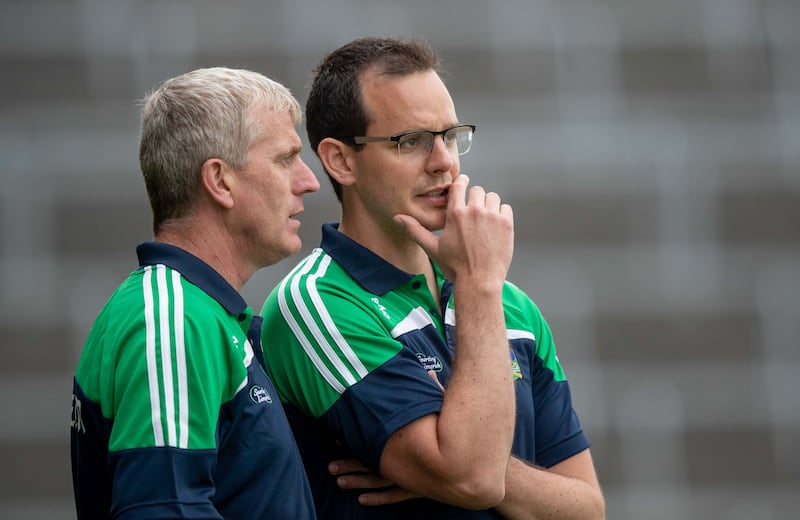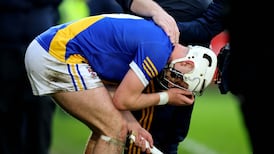The atmosphere at the Limerick-Galway All-Ireland hurling semi-final had turned molten when referee Thomas Walsh issued yellow cards to two figures on the sideline after they became engaged in a vivid verbal dispute. Given the recipients – Galway manager Henry Shefflin and Limerick coach Paul Kinnerk – the moment reflected the tension of the game.
As Tommy Walsh mischievously noted on Newstalk, it was hard to remember Shefflin getting a yellow card as a player, let alone as a manager.
And for the first time during Limerick’s regal spell, Kinnerk was transformed into an engaged presence rather than the elusive figure who has unobtrusively and steadily acquired the reputation as a hurling savant.
“He’s a genius, really,” goalkeeper Nickie Quaid enthused after last year’s championship, just one of the garlands directed at Kinnerk over the last decade.
READ MORE
Few would dispute that.
The success of Kinnerk’s coaching methodology is a yellow brick road of success and improvisation, beginning with Clare’s minor team of 2010, culminating in the 2013 All-Ireland senior success when he was recruited by Davy Fitzgerald and transferring to Limerick’s omnipotent run since his arrival in 2017.
“The biggest loss we ever had in Clare,” was the stark summary of Colin Ryan, their free -taker in 2013, after Kinnerk returned to coach Limerick development squads.
His coaching sessions drew rave notices from former players. Crystal-clear communication; original drills designed to simulate worst-case-scenarios for players; always challenging, always stimulating. The transformation to the field of play was not instantaneous.
Former Limerick defender Tom Condon reckoned the squad took over a year to fully immerse themselves in Kinnerk’s methodology – and in 2017, they did nothing to suggest the following season’s revolution.
When he was recruited by the 2010 Clare minor management of Donal Moloney and Gerry O’Connor, it was the same thing, The duo approached him after a series of tips guiding them on a hunch towards a highly unorthodox sketch of a hurling coach: a 25-year-old maths teacher who kicked football with Limerick.
“The first two or three nights at training were just constant rows,” O’Connor would recall of Kinnerk’s initial resistance to competitive training games.
“He broke down all the different skills and applications of the skills. He got them working under intense pressure and making decisions in tight and confined spaces.”
Clare reached the All-Ireland minor final of 2010 and the county won three consecutive U-21 titles between 2012-14 as well as the McCarthy Cup in 2013, when Kinnerk was moving between the senior and underage grades.
“We work away while Paul is with the Clare seniors,” O’Connor said during that halcyon time. “Then he comes back and gives us our masterclass. We are only in high infants compared to him . . . Paul completely changed the thinking behind Clare hurling.”
High praise for a coach who was still in novice years in terms of experience. It was around then Kinnerk first came to Leo O’Connor’s attention. O’Connor has just concluded a stunning season with the Offaly minors, one of the brightest GAA stories of the season which ended for them on the heartbreaking note of a late, late injury time Tipperary goal to deny them an All-Ireland title.
O’Connor also played a big part in the underage revival of Limerick hurling which has been the foundation of their current success. He believes Kinnerk’s general influence on hurling to be far-reaching. He has had the opportunity to watch him coach several times.
“It always revolves around work rate with the man coming off the shoulder where you have to do the hard yards and about how they support each other. He probably studied this before he did. I have no doubt the man could turn his hand to anything in terms of tactical approach and the way he has built in his own little empire around Limerick and Clare.
“I think Paul’s analysis in looking at a game comes from behind a goal looking up the field, the way he creates space. Look what Shane O’Donnell did in 2013. He studied, watched everything, took it all on board and devised a system that nobody has broken down. Other counties have tried to develop a master tactician, but I think he is out on his own.”

Kinnerk’s media presence is negligible. He has seldom sat down for interviews and seems to ghost out of the picture at the full-time whistle on Limerick’s gala days.
Look for him during games and you will often see him sitting in perfect stillness on the Limerick bench or standing alone, like a man lost in rapture before a masterpiece in an art gallery.
Every so often he will engage in quick conference with Kiely. In his coaching conference talks, he has cited Cian O’Neill and Donie Buckley as formative influences and also John Tuohy, who coached him as a 14-year-old for Limerick hurling development squads. As a teenager, Kinnerk had excellent potential in both games.
“Yeah, he loves both sports,” Tuohy says now. “He was very dedicated. And very much a thinker. Very astute. It was too early to say then that he would go into coaching. But in the last 10 years really he has developed.
“Obviously, his doctorate in UL was done on small-sided games and he’s clearly been thinking of how the game was played. Every decade has its style of hurling and Paul was very much aware of that. I think he was developing his system with Davy Fitz’ in Clare in 2013 but he really took off with the small-sided game approach.
“That is where he was developing his archetype, his skill. His management style and skills are very clear, and he is an excellent communicator. He can bring an idea to a player and look at a player and see what he can bring to the game itself. They develop the players to play a certain style and it is working very well. And it all plays into their system, which really is a small-sided based system.”
The fine detail has resulted in Limerick storming through the record books. The decade of concerted underage academy work has resulted in a generation of hurlers who are both technically excellent, highly athletic and physically imposing.
Under John Kiely, they have found an exceptional management team; the manager has from the outset emphasised the role of psychologist Caroline Currid and Kinnerk.
Because he was from the football citadel of Monaleen, Kinnerk’s playing ambitions gravitated towards football.
His role in transforming Clare’s fortunes coincided with his peak years as a player and he operated a berserk dual schedule as both inter-county player in football and trailblazing coach in another code. A recurrent injury cut his football career short, but he has used those years to inform his coaching of the players under his stewardship.
“I always felt that I was a better player when I was put out of my comfort zone,” he said at a conference in 2016.
“And I think that is very important. You are constantly assessing that in a training context. How to put players outside of it, how to put them in worst-case-scenarios. In 2008 and 2009 I would have done stuff back then that I probably wouldn’t do now and I would like to think some of the stuff would be better.
“I suppose we are all on a journey and our philosophies are formed and our coaching standards are formed by our own playing careers, coaching courses, talks like today.”
The early season suggestion that Limerick might be waning gave other counties false hope. Their comet has been hurtling through the sky all summer and now they stand on the threshold of a third consecutive All-Ireland.
Comparisons with the all-conquering Kilkenny team of 2006-2010 are obvious and it is apt that the latest iteration of Brian Cody’s Kilkenny should now stand in Limerick’s way. One of the intrigues of this game is that it appears to set the virtues of traditionalism against the new science of Kinnerk’s vision, but it is not that straightforward.
“I think there has always been a myth about Kilkenny,” says Leo O’Connor. “I know Kilkenny players do weight training, that Kilkenny do tactics. Yes, Brian Cody has set his teams up in a consistent way and Kilkenny have a system and they play it at minor and U-20; when the man gets a ball he turns and takes his man on and if the goal is on, he goes for the jugular.
“But they will tweak it too – and you can see [goalkeeper] Eoin Murphy playing the ball through the lines or the conversion of Padraic Walsh to half forward. With Limerick it is not always direct. But for 20 minutes last year in the All-Ireland final, Limerick went for the jugular and destroyed Cork with three goals. That was like the Kilkenny of old.”
There will be an almighty clash of two formidable wills and belief-systems. Cody’s genius for ensuring that his teams peak at required moments has been the signature note of an extraordinary reign.
But Limerick’s faith in the same under Kiely has guided them through this summer’s close calls against Clare and Galway. Everything suggests Kilkenny will provide an exacting inquisition of Kinnerk’s system.
Still, what makes the Kinnerk project so intriguing is that he is still precociously young as a coach and is learning and evolving all the time. Recruiting him to the service of his native county has been central to Limerick’s transformation. They won’t be letting him go any time soon.
















